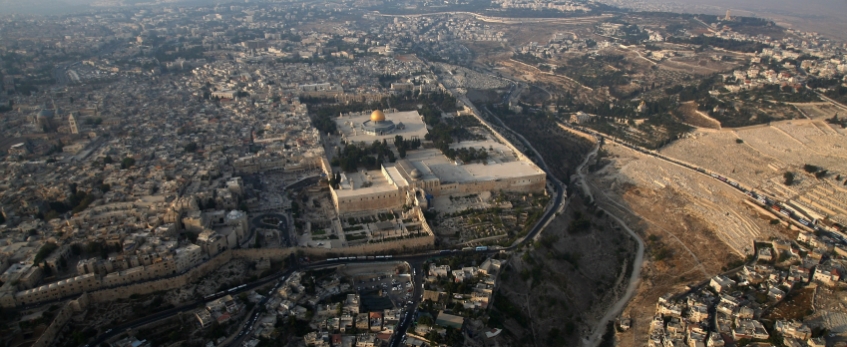For centuries, Jerusalem has been the political, administrative and spiritual heart of Palestine. Metropolitan East Jerusalem – an area extending from Ramallah to Bethlehem – has for long been the driving force of our economy. In fact, nearly one-third of our economic activity is centered around East Jerusalem. Given East Jerusalem’s economic, cultural, social and religious importance, without East Jerusalem, there can be no viable Palestinian state.
Though central to three faiths, Israel has since 1967 systematically pursued policies aimed at ensuring exclusive control over the city with disregard to the rights of the indigenous Christian and Muslim Palestinian populations. In so doing, Israel unilaterally is taking control of East Jerusalem, the future capital of our state, thereby putting at risk the possibility of a two-state solution.
Modern History of the Holy City: A Brief Overview
- When the UN General Assembly recommended in 1947 to partition Palestine, Jerusalem and its environs (including the city of Bethlehem to the south) were to be administered internationally as a separate entity, or corpus separatum. However, during the 1948 war, Israel invaded the corpus separatum and occupied 85 percent of its territory.
- In June 1967, Israel occupied the remainder of Jerusalem, or “East Jerusalem”, including the Old City. Only weeks later, Israel unilaterally expanded the municipal borders of Jerusalem, enlarging East Jerusalem ten-fold. The new borders were drawn to incorporate undeveloped Palestinian lands and excluded our population centers. During the 1970s, those undeveloped lands were illegally confiscated by Israel to build Israeli settlements, in violation of international law.
- With the expansion of Jerusalem’s borders, Israel applied its laws, administration and jurisdiction over the expanded area of municipal Jerusalem (an area then covering 72 km2 or 1.3 percent of the West Bank) in a clear attempt to de facto annex East Jerusalem and parts of the West Bank. This annexation violated the prohibition against acquiring territory by force and was declared of “no legal validity” by the UN Security Council.
Changing Demographics
Since 1967, the Israeli government has attempted to consolidate its control over Jerusalem by systematically pursuing a number of policies:
-
Establishing Settlements:
Israel has unilaterally annexed occupied East Jerusalem and has been constructing illegal settlements within and along its illegally expanded borders. These settlements now form a ring around the entire occupied part of the city, sealing it off from the rest of the West Bank. Today, over 220,000 settlers live in occupied East Jerusalem alone.
-
Revoking Residency Rights and Denying Family Reunification:
Israel’s goal with respect to its policies in occupied East Jerusalem has been clearly and repeatedly stated to be the preservation of a Jewish demographic majority in Jerusalem. This goal was officially stated in a 1973 report by the inter-ministerial Committee to Examine the Rate of Development for Jerusalem. In this report the recommendation was made that the “demographic balance of Jews and Arabs must be maintained as it was at the end of 1972.” In an attempt to maintain this “demographic balance,” Israel has prohibited thousands of Palestinians from residing in the city of our birth by revoking our residency rights.
As “Permanent Residents” of Israel, Palestinian East Jerusalemites have disproportionate rights compared with Israeli citizens of the city. For example, Israel has the power to strip them of their residency solely at its discretion. Therefore, our residents of occupied East Jerusalem must maintain their “center of life” in East Jerusalem; otherwise they run the risk of losing their residency status. In addition to residency revocation, Israel habitually refuses to grant Palestinian spouses of non-Jerusalemites residency status, thereby preventing them from residing in Jerusalem and denying family unification.
More than 14,600 Palestinian “permanent resident” identification cards were revoked between 1967 and today, directly impacting more than 20 percent of our families in occupied East Jerusalem.
-
Land Confiscation, Building Restrictions and Home Demolitions:
In addition to preventing our urban growth by confiscating our lands and constructing settlements, Israel has adopted a series of discriminatory zoning policies intended to make it difficult for us to build on our land or to expand existing structures. As a result, we are only allowed to build and live on 13 percent of East Jerusalem. Further, permits to build within those areas are expensive and nearly impossible to obtain due to Israel’s restrictive and discriminatory measures and policies, thereby giving the Israeli government the ability to demolish homes where building, including expansion, was carried out without an Israeli permit. Latest studies indicate a lack of at least 60,000 housing units while approximately 25,000 structures are built without licensing permits, constituting about 40% of all houses in Palestinian neighborhoods.
These discriminatory policies have also resulted in severe over-crowding in East Jerusalem, a situation which will only worsen as the population naturally expands. From 1967 until today, the Palestinian population of Israeli-defined municipal Jerusalem has grown from 68,600 to 361,000—an increase of 190 percent.
Estimates also indicate that since 1967, Israel has demolished more than 3,700 homes and other structures in East Jerusalem, including several historic and religious sites, such as the historic Moroccan Quarter in the Old City of Jerusalem.
Since March 1993, Israel has prohibited non-Jerusalemite Palestinians from entering the city unless they obtain an Israeli-issued permit, which is rarely granted. As such, over 4 million Palestinians are denied access to our holy places in Jerusalem, are prohibited from studying in East Jerusalem and are denied certain medical treatments that are only available in East Jerusalem hospitals.
The route of the Wall in and around occupied East Jerusalem splits the West Bank into two distinct areas and completely isolates occupied East Jerusalem from the rest of the West Bank.
It also limits the last available space for much needed Palestinian growth, while facilitating the construction and expansion of settlements. Furthermore, the Wall severs the national transportation axis that connects the West Bank with Jerusalem and has resulted in an influx of Palestinian Jerusalemites to the center of the city.
